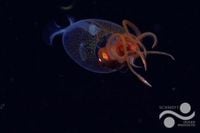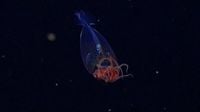In a remarkable breakthrough for marine biology, scientists have captured the first-ever footage of a colossal squid swimming in its natural habitat, nearly a century after the species was first discovered. This historic moment occurred during a 35-day expedition by the Schmidt Ocean Institute aboard the research vessel Falkor (too), which took place near the South Sandwich Islands in the South Atlantic Ocean.
The footage showcases a juvenile colossal squid, measuring approximately 30 centimeters (about 11.8 inches) in length, filmed at a depth of 600 meters (1,968 feet) on March 9, 2025. This sighting is particularly significant, as the colossal squid (Mesonychoteuthis hamiltoni) is known to be the heaviest invertebrate on Earth, capable of growing up to 7 meters (23 feet) long and weighing as much as 500 kilograms (1,100 pounds).
Dr. Kat Bolstad, an associate professor at the Auckland University of Technology and a leading squid researcher, expressed her excitement about the discovery. "For 100 years, we have mainly encountered them as prey remains in whale and seabird stomachs and as predators of harvested toothfish," she said. "It's exciting to see the first in situ footage of a juvenile colossal and humbling to think that they have no idea that humans exist."
The colossal squid was first described in 1925 based on specimens found in the stomach of commercially hunted sperm whales. Until now, little was known about its life cycle, and most encounters with the species had involved dead specimens.
The footage was captured using a remotely operated vehicle (ROV) named SuBastian, which allowed researchers to observe the squid in its deep-sea environment without disturbing it. The expedition aimed to uncover new marine life and habitats in the underexplored regions of the southern Atlantic, primarily focusing on the seafloor.
Interestingly, the juvenile squid's transparent body, a characteristic of younger individuals, is expected to change as it matures. Dr. Bolstad noted that the red coloration observed in the arms suggests that this creature could switch between appearing transparent and opaque, a feature that helps it evade predators.
In addition to the colossal squid, the research team also spotted a glacial glass squid (Galiteuthis glacialis) during a separate encounter. This species, which can grow up to 50 centimeters (20 inches), is often confused with the colossal squid due to their similar transparent appearance. However, the presence of hooks on the middle of the colossal squid's eight arms distinguishes it from its glass squid relatives.
Dr. Michelle Taylor, chief scientist on the expedition, highlighted the importance of the discovery. "The first sighting of two different squids on back-to-back expeditions is remarkable and shows how little we have seen of the magnificent inhabitants of the Southern Ocean," she commented.
Despite their enormous size and weight, colossal squids are elusive creatures that live in the depths of the ocean, making them difficult to study. Their natural habitat is characterized by extreme conditions, including darkness and high pressure, which presents challenges for researchers attempting to observe them.
Until this recent expedition, much of the knowledge about colossal squids was derived from the remains found in predator stomachs or from accidental catches in fishing nets. The successful filming of a juvenile squid not only provides valuable insights into its behavior and biology but also raises new questions about its life cycle and ecological role.
The expedition was a collaboration between the Schmidt Ocean Institute, the Nippon Foundation-NEKTON Ocean Census, and GoSouth, a joint project involving several research institutions. This international effort underscores the significance of deep-sea exploration and the need for continued research in understanding the mysteries of the ocean.
As the footage of the juvenile colossal squid circulates among scientists and the public, it serves as a reminder of the wonders that the deep sea holds. The ocean is home to countless undiscovered species and ecosystems, and this discovery marks a significant step in uncovering the secrets of one of the planet's most enigmatic creatures.
In addition to the colossal squid, the Falkor (too) team also documented a glacial glass squid earlier in January 2025, further emphasizing the rich biodiversity of the southern ocean. These discoveries highlight the delicate beauty of deep-sea animals, contrasting the often sensationalized portrayal of such creatures in popular media.
In conclusion, the first confirmed sighting of a colossal squid in its natural habitat not only enriches our understanding of this remarkable species but also emphasizes the importance of continued exploration and conservation efforts in the deep sea. As researchers continue to unveil the mysteries of the ocean, each new discovery brings us closer to understanding the intricate web of life that thrives beneath the waves.





